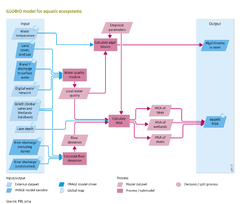Aquatic biodiversity/Description
Parts of Aquatic biodiversity/Description
| Component is implemented in: |
|
| Projects/Applications |
| Models/Databases |
| Key publications |
| References |
Model description of Aquatic biodiversity
GLOBIO aquatic assesses biodiversity intactness,expressed as mean species abundance (MSA) in inland aquatic ecosystems: rivers and streams, deep and shallow lakes and wetlands such as floodplain wetlands, marshes, and isolated wetlands. See Figure Flowchart.
The model calculates the effects of land use changes in catchment areas in each of the aquatic ecosystems listed. For rivers and floodplain wetlands, the model also describes the effect of human interventions (e.g., through dam construction or climate change) on the hydrology on biodiversity. From a biodiversity perspective, reservoirs are considered as heavily modified river stretches. GLOBIO is also used to compute the probability of the dominance of harmful algal blooms of cyanobacteria (blue-green algae) in lakes, which often coincides with shifts in food webs and biodiversity loss, and which interferes with the human use of these systems.
The land-use effect on MSA in streams, rivers and wetlands is based on the type and proportion of human land use in the upstream catchment areas. Data from studies on biodiversity in rivers and streams in catchment and sub-catchment areas with different types of land use (e.g., forest, agriculture, urban) were combined in a meta-analysis. The data were expressed in MSA and fitted by linear regression (Weijters et al., 2009). A comparable meta-analysis was performed for wetlands (Janse et al., submitted). The analysis for lakes was based on phosphorus and nitrogen loadings, because the effects of eutrophication on lakes are well established, and nutrient loading to surface waters correlates closely with the type and intensity of land use (Harper, 1992; Bouwman et al., 2013c). Data from literature on the relationship between biodiversity and P and N concentrations were combined and fitted by logistic regression for deep and shallow lakes (Janse et al., submitted).
Local concentration levels are calculated from nutrient discharges to surface water (Component Nutrients) and their accumulation and processing along the river network (see Component Water), currently using 0.5x0.5 degree resolution data. The model uses data on water bodies (streams, rivers, lakes, reservoirs and several types of wetlands) from the GLWD Global Lakes and Wetlands Database (Lehner and Döll, 2004) to calculate the proportion of each water body type in each grid cell. Lake depth categories were derived where possible from the Flake database (Kourzeneva, 2010).
The river network and GLWD map were combined in an overall water network map to estimate nutrient loadings to water bodies. Some wetland types are assumed to be isolated from the river network and thus only influenced by the land-use and nutrient emissions in the specific grid cell. An adapted wetland map can be used to take account of historical or projected wetland conversions to other land-use (Van Asselen et al., 2013).
For rivers and riverine wetlands, GLOBIO also considers the effect of hydrological changes on biodiversity. Monthly river discharges in pristine and in present or future situations (affected by climate change, dams and water abstraction) are derived from the hydrology module in LPJ model ((Component Nutrients). These monthly discharge patterns are used to calculate the deviation between affected and natural seasonal pattern, referred to as the Amended Annual Proportional Flow Deviation (Ladson and White, 1999; Biemans et al., 2011). Literature data on biodiversity in rivers under different regulation (e.g., by dams) were combined and expressed as a change in MSA (Janse et al., submitted). A comparable analysis was performed on the effects of flow deviation of biodiversity in riverine wetlands (Kuiper et al., 2014).
The MSA value for each water body (river, lake, wetland) is calculated by multiplying the values for the relevant drivers. The final indicator, aquatic MSA, is calculated by area-weighted averaging of MSA values for rivers, lakes and wetlands. In addition to MSA, the probability of dominance of harmful algal blooms of cyanobacteria in lakes is calculated as a biodiversity indicator, based on P concentration, N:P ratio, and water temperature (Håkanson et al., 2007. The results are expressed as the proportion of lakes with a cyanobacteria biomass above the WHO standard.
A more detailed description of the model is published in (Alkemade et al., 2011b; Janse et al., submitted).
